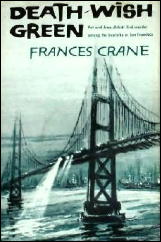Thu 28 Apr 2011
A 1001 MIDNIGHTS review: FRANCES CRANE – Death-Wish Green.
Posted by Steve under 1001 Midnights , ReviewsNo Comments
by Marcia Muller
FRANCES CRANE – Death-Wish Green. Random House, hardcover, 1960. Hardcover reprint: Detective Book Club, 3-in-1 edition. No paperback edition.

Pat and Jean Abbott, a private investigator and his wife, are returning to foggy San Francisco from a weekend in the sun. As they reach the toll plaza of the Golden Gate Bridge, they spot a familiar car being inspected by highway patrolmen and the local police. The car, which was abandoned on the bridge, belongs to Katie Spinner, daughter of friends of the Abbotts; and it appears she has jumped off the bridge.
Jean Abbott, however, is not convinced the girl committed suicide; and when Pat is hired by Katie’s aunt to investigate the disappearance, it becomes apparent Katie is still alive.
The Abbotts, who often work as an investigative team, focus on bohemian North Beach, one of the last places Katie was seen before she started across the bridge. There they encounter an art-gallery dealer with a taste for Zen Buddhism and opium; a model who calls her favorite color “death-wish green,” and dies wearing it; a mysterious stranger with a large auburn beard who was seen with the missing girl in a coffeehouse; and errant sons and daughters of some of the city’s wealthiest and most respected families.
For all Pat Abbott’s investigative skills, in the end it is Jean who sees most of the action and carries the day.
Frances Crane’s descriptive powers are considerable, and the sense of place — particularly of the fog and its effect on San Francisco — is powerful. Her secondary characters are well drawn and indeed far more vividly drawn that either Pat or Jean. Jean, the narrator/observer, remains just that, and we come away without really having gotten to know her. Pat, the detective, is merely a figure going through investigative motions.
Frances Crane has written many other novels, all of them with colors in their titles, featuring the Abbotts. Among them are The Amethyst Spectacles (1944), The Buttercup Case (1958), and The Amber Eyes (1962).
In addition to San Francisco, they are set in such locales as Tangier (The Coral Princess Murders, 1954); New Mexico (Horror on the Ruby X, 1956); and New Orleans (The Indigo Necklace, 1955).
———
Reprinted with permission from 1001 Midnights, edited by Bill Pronzini & Marcia Muller and published by The Battered Silicon Dispatch Box, 2007. Copyright © 1986, 2007 by the Pronzini-Muller Family Trust.
Previously on this blog:
The Cinnamon Murder (reviewed by Steve Lewis)